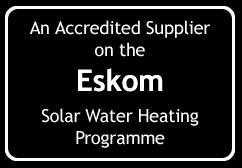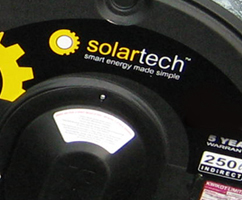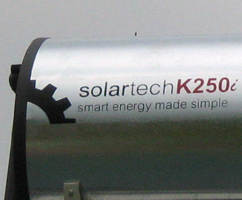

December 29th 2010This year has turned out to be a boom year for the solar industry, thanks in no small part to lucrative government subsidies in Europe, particularly in countries such as Germany and Italy. New solar project installations shot up from 7.2 GW in 2009 to an estimated 15.8 GW in 2010, according to iSuppli. But analysts are predicting slower growth in 2011 because incentives in these key European markets are set to fall quite a bit. At the same time the U.S. market could grow faster. Here are key trends I expect to see in 2011: 1. The rise of the U.S. market. Given the size of the country, solar industry folks have long counted on the U.S. as becoming a dominant solar electricity generator one day. We?ll likely see a particularly big upswing in that direction because of a confluence of state and federal policies. Congress just extended a popular grant program that helps to cover 30 percent of the cost of installing solar projects. The extension will end Dec. 31, 2011, and projects that start construction by the deadline will still qualify to get the money. That deadline will prompt companies to quicken their project development pace. Project developers who have signed contracts to sell solar electricity to California utilities had also better get going on completing their work. The state?s three big utilities are supposed to buy enough renewable energy to make up 20 percent of their supplies by 2010. The utilities aren?t likely to be able to make that deadline, but state regulation gives them until the end of 2013 to comply. Meanwhile, the utilities will have to make sure they line up enough contracts or install their own projects to meet the 33 percent goal by 2020. 2. The money spigot opens up. Banks and other project investors seem to have boosted their financial support in 2010, and more money should flow forth. U.B. Bank, the venture capital arm of Pacific Gas and Electric Corp. and Rabobank have put up millions for residential and commercial installations, while NRG Energy emerged committing to invest up to $1.55 billion for utility-scale projects by SunPower, BrightSource Energy and First Solar. Lining up money for a project that exceeds 100 MW remains tough, but smaller projects are more palatable (and their development cycle is shorter). California could launch a 1-GW program sometime next year to encourage projects of up to 20 MW in size. Utilities in the rest of the country are also pursuing smaller projects. And let?s not forget the biggest banker of all: the U.S. government. The federal government has offered big loan guarantees followed by the loans themselves to solar manufacturers and project developers in the past two years, including the $400 million to Abound Solar and $1.45 billion to Abengoa Solar. A portion of the loan guarantee program, (Section 1705) is set to end next year, and projects that want to qualify must start construction by September 2011. 3. Utilities embracing ownership. Owning power plants gives utilities control over electricity production costs and comes with tax benefits, including a 30 percent investment tax credit approved by Congress in 2008. So the solar industry has expected utilities to invest their own money in solar projects. The aggressive moves by NRG Energy (which is a wholesale power generator that owns two utilities) to invest in a host of solar projects in the past two years will nudge more utilities to move quicker into the game. Other players who already have plans or projects in place include Pacific Gas and Electric, Southern California Edison, Florida Power & Light, and Duke Energy. 4. Factory boom. Many solar cell and panel manufacturers are expanding their factories at a dizzying pace, and the biggies will only become bigger, making it even harder for startup companies and definitely brand entrants to compete. First Solar vows to nearly double its production capacity from 1.4 GW in 2010 to 2.7 GW by 2012. Suntech Power expects its cell and panel production capacity to surge from 1.8 GW in 2010 to 2.4 GW in 2011. JA Solar already has reached 1.9 GW of cell production capacity by November of this year. Solar Frontier is building a 900-MW factory that is set to come online next year; it currently has two factories of 80 MW total. Good luck to those startups that haven?t lined up public or private financing to catch up. SpectraWatt, which started production at its 60-MW factory in New York this year, recently announced plans to lay off more than 100 employees and close the factory by spring 2011. 5. Make the gear AND build the projects. For a while, being both an equipment manufacturer and a project developer seemed an unwise undertaking. OptiSolar went bust; Suntech Power?s project development business in the U.S. didn?t take off. But SunPower and First Solar have shown that being successful at doing both is possible and a good way to create outlets for their solar panels. This year we saw Sharp buy Recurrent Energy for $305 million, SunPower buy SunRay Renewable Energy in Europe for $277 million and First Solar buy yet another project developer, NextLight, for $297 million. I continue to read about new project developers entering the business. Coupled with some of the existing ones that are having a hard time lining up project financing, the market is set for more acquisitions. 6. Solar thermal farms ? a losing proposition? California regulators approved nine solar thermal power projects totaling more than 4 GW in the past four months, and that would seem to invite a whole lot of new projects. But more likely, you won?t see a raft of new proposals to build giant power plants using mirrors to concentrate the sunlight for producing steam, which then drives generators. Solar thermal farms need to be large ? a few hundred megawatts seem to be the norm ? in order to be economically feasible. But lining up financing for this type of project might be more difficult than for a project that uses solar panels, the price of which has fallen 50 percent in the past two years. Mega thermal projects are prone to elicit criticism and even lawsuits for their impact on the environment, from water use to wildlife survival. Tessera Solar?s two projects, dubbed Calico and Imperial Valley, are prime examples of what could go wrong. Tessera announced yesterday that it had sold the 850-megawatt Calico project to K Road Power. Its other project is facing a lawsuit from the Quechan Indian Tribe. 7. Hybrid solar market slowly emerges. A slew of startup companies have gradually rolled out hybrid systems that generate electricity and heat to create hot water or run heating and cooling systems at homes and businesses. Cogenra Solar installed its first pilot project at a northern California winery this summer, while PVT began selling its equipment to home builders in 2009. Cool Energy lined up a Colorado utility, Xcel Energy, to help launch a pilot project this year. Chromasun plans to launch its first hybrid system in 2011. Not only are the technologies getting ready, the incentives also are materializing. California launched an incentive program for solar water heater installations earlier this year. New York started a program earlier this month. Both states also offer incentives for solar electric systems and allow hybrid systems to claim incentives from both programs. 8. Canadian solar soars. The Ontario province of Canada launched a feed-in tariff program in October 2009 and became a hot bed of solar development activities. The province has also learned a few lessons about shaping its popular program to manage the explosive growth. The Ontario Power Authority, which runs the program, plans to tweak it even more in the coming year, including cutting the prices set for utilities to buy solar electricity from project developers. Ontario will also have to contend with complaints from Japan and maybe other countries over the province requiring the majority of the equipment and services from each project to come from within Ontario. Those who advocate a similar policy in the U.S. should take note on how the Ontario program pans out. Feed-in tariffs have successfully created large solar markets in Europe, but have also drawn detractors who believe competitive bidding ? rather than having the government set solar contract pricing ? leads to more cost-effective projects. 9. IPO solar market remains lukewarm. Many solar startups have dreamed of launching a successful IPO and becoming the next First Solar. Nothing like that happened in 2010 and solar companies still seem to be risky bets. IPO candidates will have to show they can make money, especially as solar energy equipment becomes a commodity and as many project developers continue to have trouble lining up money to finance installations. Out of our potential IPO picks of 2011, BrightSource Energy seems to generate the most buzz. But I think investors will continue to be cautious and skeptical about solar in 2011. 10. Building solar PV market to perk up. After years of making promises, several thin-film solar manufacturers finally unveiled flexible panels designed to blend into residential and commercial rooftops. Dow Chemical plans to start selling shingles embedded with solar cells in mid-2011. Meanwhile, starting next year, builders of large residential communities in California (more than 50 homes) will be required to offer solar panels as a standard option. This rule will help promote building-integrated photovoltaic installations, which appeal to homeowners who don?t want their solar electric systems to standout, aesthetically speaking. Source: Reuters |




